Student Name /
Advanced Sculpture, 2014
Project 1: Process
ARTIST RESEARCH
Ana Mendieta
Through her performative works, Cuban-born artist, Ana Mendieta explores and crosses between the realm of the ephemeral and the perpetual through her process-based technique of inserting her body into natural settings and landscapes and documenting them through photography or videography. More specifically in her series, Siluetas, Mendieta imprints her body onto the earth leaving behind beautiful yet haunting outlines of her body. She engages in this process of camouflaging or fashioning herself within elements of nature such as stone, leaves, dirt, mud, branches, and even, in some cases, fire and gun powder (Julie Warchol). Siluetas invokes not just Mendieta’s representation of the feminine body but also the power of the feminine body and the “spirit of renewal inspired by nature” (Julie Warchol). What is most intriguing about Mendieta’s work is that she concerns herself with that of a private and intimate relationship to nature that is interestingly enough both temporary and permanent. She states “my art is the way I reestablish the bonds that tie me to the universe”She bases her work in the moment of the performance, placing herself so carefully into these areas of nature and literally and metaphorically building a relationship with the earth. Yet soon after, she leaves the site, leaving her imprint behind only to be slowly eroded away by the hands of nature. However she perpetuates these moments through photographic and video documentation which in turn, allows her to translate these private ritual performances as public process art.
In the first work, Anima, Silueta de Cohetes from the Siluetas Series in Mexico (1976), Mendieta pieces together branches and candles to form the outline of her body which she then props up using a stand made from the same material. With these elements, she outlines her body in the sky thus creating a concrete relationship between the earth, sky, and herself. She then spiritualizes this process when she proceeds to burn the candles which in effect, burn away the branches and slowly erases her outline from existence and turns it into ash. Though this work is temporary, the essence of her spirit remains within work and the video as she captures the process of her outlined body burning and fading away in the wind. It is almost as if her spirit fades into the sky and flows back into the universe. In the second work, Untitled, from the Siluetas Series in Mexico (1973) she actually places her body within a natural scene and fashions flowers over herself so that her body appears to be just another part of the natural setting. In this work she is more directly projecting the representation of the feminine body in a natural state as well as the relationship and direct connection of the body to nature. Blake Gopnika distinguishes Mendieta and Jackson Polluck who is believed to be the founding father of process art, saying that she reduces his “ego-laden drips…to a single bloody, hand-shaped smear” (Blake Gopnika). Like process art denotes, the work is not about the artist but rather how it was created and lives on

Ana Mendieta, Anima, Silueta de Cohetes from the Siluetas Series in Mexico (1976),
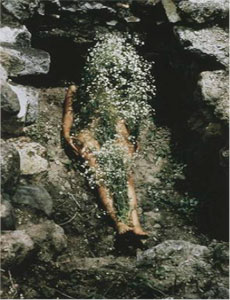
Ana Mendieta, Untitled, from the Siluetas Series in Mexico (1973)
Janine Antoni
With out a doubt, the work of Janine Antoni is very much process and material orientated because the viewer can see both the physical labor of the artist as well as the intimacy between herself and the material that she is using. Antoni is most known for her sculptural performance pieces in which she combines her love for classical art with an intimate relationship between her body and the material. In fact, Antoni uses her body as the tool with which she uses to construct and deconstruct materials to alter their forms as well as form these intimate relationships (Bomb Magazine, JSTOR). In an interview with Framing Sculpture, Antoni talks about “the process of surrendering to the object” (Framing Sculpture interview). She says “if you have enough courage and sensitivity to listen, you kind of let…the dialogue go back and forth between you and the material”. (Janine Antoni, Framing Sculpture interview). This dialogue between her and the material as well her strong relationship to her materials drives her process to make, construct, and deconstruct and do so in extensive and labor intensive process. Antoni spends a great amount of time just preparing her work and practicing for her performances. Specifically in her piece Touch, she prepared for her performance piece, by practicing tight rope walking for one hour each day, every week. (Art 21 “Loss and Desire” video). She did this in conjunction with actually creating her own tight rope (which was 100ft long and 8ft from the ground) from hemp in period of 16 months (Art in America Magazine). In her piece, Lick and Lather, she spends hours casting and replicating exact molds of her bust in both chocolate and soap and she then proceeds to repeatedly lick the chocolate busts and bathe for hours with the soap busts until the features dissolve away or are altered. In her piece Gnaw, she continuously bites away at 600 pound blocks of lard and chocolate until she is exhausted and their forms are altered.
Looking more closely, her pieces Gnaw and Lick and Lather, were created by her body. In the way that a sculpter uses sculpting tools as connection between their hand and the material, Antoni actually goes further to eliminate this middle man and makes her body the direct tool to the material. In doing this, she engages in the lengthy processes of biting, chewing, licking, touching, tasting, and bathing in order to make, build, construct, deconstruct, wash and fade away images important to her and, on a larger scale, images of women that are important to society.
In Gnaw, Antoni places two 600-pound blocks on pedestals. One block is made of chocolate while the other is made of lard. In this piece, she performs a kind of primal process of biting, gnawing, and chewing away at each block. As a sculptor, she is demonstrating the act of figure sculpture that is reminiscent of classical art and sculpture. Similar to how Michelangelo carves figures from marble with a chisel and hammer, Antoni creates a new, more figural form from the blocks of chocolate and lard using her mouth. The social concept of beauty image for women is also manifested through her work as well as she uses two contrasting but connected materials that hold significance for most women. Chocolate is a very desirable and tantalizing object that women love to indulge in but lard or fat is a very undesirable outcome of over-indulging in chocolate. By placing the blocks together, Antoni shows the relationship the materials have to one another by being both fats but also the relationship that they have to women with chocolate being a fat that is desirable and craved but lard being a fat that is feared and socially unacceptable. Antoni shows the struggle of how women love chocolate but fear being fat by placing these objects of equal weight and same structure next one another and then biting into both of them. Yet at the same time, by biting into both of these struggles and effectively making figures of their forms, she addresses the question of whether or not women should let go of these fears and ideals of beauty and allow themselves to indulge and let themselves go. Antoni takes it further by creating desirable things from the pieces that were chewed off from the blocks. From the chocolate, she meticulously constructs 45 heart-shaped chocolate boxes and from the lard, she creates 150 pigmented lipsticks (Bomb Magazine, JSTOR). She contradicts the image of beauty and fear of gaining weight by constructing the lard into lipstick—an item women use to make themselves beautiful and taking the more desirable object of chocolate and making it into a container that holds chocolate and is given as a gift to express affection. In effect, this shows the inevitable nature of fat—that it exists around us and is even incorporated in the things we use to make ourselves beautiful and more desirable.
In her work, Lick and Lather, Antoni further engages her body as a tool by casting exact replica molds of herself in both chocolate and soap. She creates 14 replicas of herself, 7 of which are made from soap, and the other 7 are made from chocolate. (Wadsworth Atheneum). This process connects her to her material on a much more intimate and personal level. She creates a replicated image of herself so that she can “be on the outside of [herself] and have a relationship with [her] image” (Janine Antoni, Art 21). She then proceeds to have her body act on her image by licking away and altering the features of her bust casted in chocolate and bathing and fading away her features of her soap casted bust. She spends time with each cast, constructing and deconstructing them—similar to how she approached her work with Gnaw. Also like Gnaw, with Lick and Lather, Antoni takes a different approach to a classical style of sculpture and classical busts. “I wanted to work with the tradition of self-portraiture but also the classical bust”, says Antoni. (Janine Antoni, Art 21). In creating these busts and even carving the classical stands on which the busts rest, Antoni addresses two issues of making busts of the self which are immortalizing one’s self through portraiture and busts and making an image of the self to be viewed by the public. She addresses the issue of immortality by playing with this desire to achieve immortality through sculpture as she uses ephemeral materials to make these molded images of herself. She then plays on the ephemerality of the sculptures even further by licking and bathing with them until the features are altered or fade away. Antoni then makes a point to question even the lifespan of stone because even stone busts and sculptures begin to erode away overtime—so then how can one achieve immortality if even their stone sculpture can’t stand the test of time? With the issue of creating an image of one’s self for public viewing, the purposes of chocolate and soap actually put into question what an accurate image of the self actually looks like. “Are we more ourselves alone at home eating a meal or in the bathtub, in these everyday activities? So, that’s where I got the idea to work with the chocolate and the soap” (Janine Antoni, Art 21). Antoni also addresses the issue of societal perceptions of women. Just like she had done in her work Gnaw, Antoni uses two contrasting materials that have similar connections to the feminine body. Soap is what we use to clean our bodies—in a way, it purifies us from dirt and dust collected from being outside. The act of bathing and purification is also ritualistic. So putting together this idea of soap and bathing as ritual of purification, Antoni relates it back to societal perception or moreso expectation that woman’s body is sacred and should remain pure until marriage, as some religions denote. Antoni also relates this purity to that of a fetus and how untouched and undeveloped and how when she rubs away the features of her bust it represents the reversion back to the fetal stage when features are still indefinable. She explains her feelings of holding a fetus as she bathed with the soap busts saying, “I really feel close to the soap bust because we spent a lot of time in the tub together. And I just sort of rub her all over and, you know, she sort of smoothes down, and then she becomes almost fetal” (Janine Antoni, Art 21). She contrasts soap and this ritual process of purification with the seductive, desirable nature of chocolate. Just as in Gnaw, chocolate represented a desirable and addictive substance. In fact, Antoni explains that “the thing about chocolate is that it has the product phenylamine in it. That product is the chemical that’s produced in our body when we’re in love. So, I think that’s why chocolate is so addictive” (Janine Antoni, Art 21). So in relation to the female body, on one hand, there is the perception of purity and sacredness of a woman’s body but there is also the perception of the seductive nature of a woman’s body and how, like chocolate, it is very desirable and addictive when affection is involved. Antoni also acts on this material in a tender and almost erotic way by licking away the eyes, lips, neck, and even hair of the chocolate busts. Yet this a characteristic of her intimate relationship with her materials and emphasizes her as indeed a process artist who utilizes her body as the tool, spends time with her materials, and engages in numerous hours of labor intensive work.
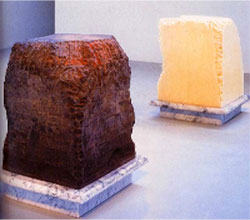
Janine Antoni
Gnaw, 1992
600 lbs. of chocolate and 600 lbs of lard gnawed by the artist
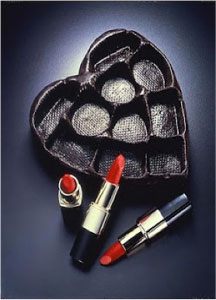
Janine Antoni
Gnaw, 1992
600 lbs. of chocolate and 600 lbs of lard gnawed by the artist
45 heart-shaped packages for chocolate made from chewed chocolate removed from the chocolate cube and 150 lipsticks made with pigment, beeswax and chewed lard removed from the lard cube
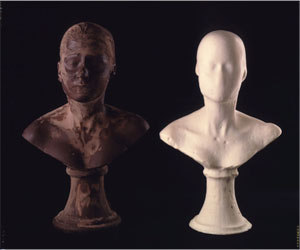
Janine Antoni
Lick & Lather, 1993
Two busts: one chocolate and one soap
From an edition of 7 with 1 artist's proof + 1 full set of 14 busts, 7 of each material
24 x 16 x 13 inches (60.96 x 40.64 x 33.02 cm)
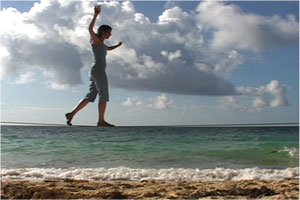
Janine Antoni
Touch, 2002
Video installation
Edition of 5 with 2 artist's proofs
132 X 178 inches (335.28 X 452.12 cm)
Duration: 9.37 minute loop
Back to Index
This page was last updated:
March 25, 2014 1:17 AM